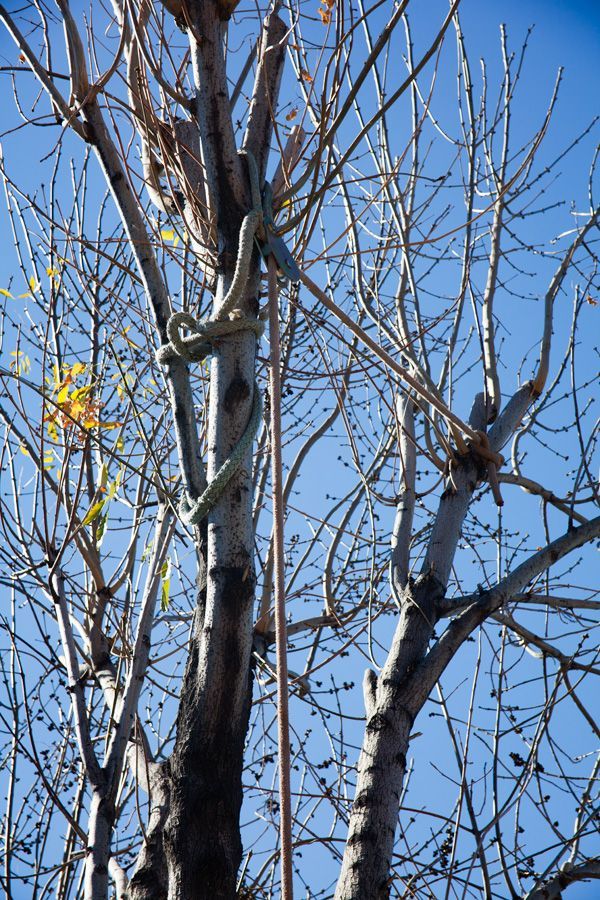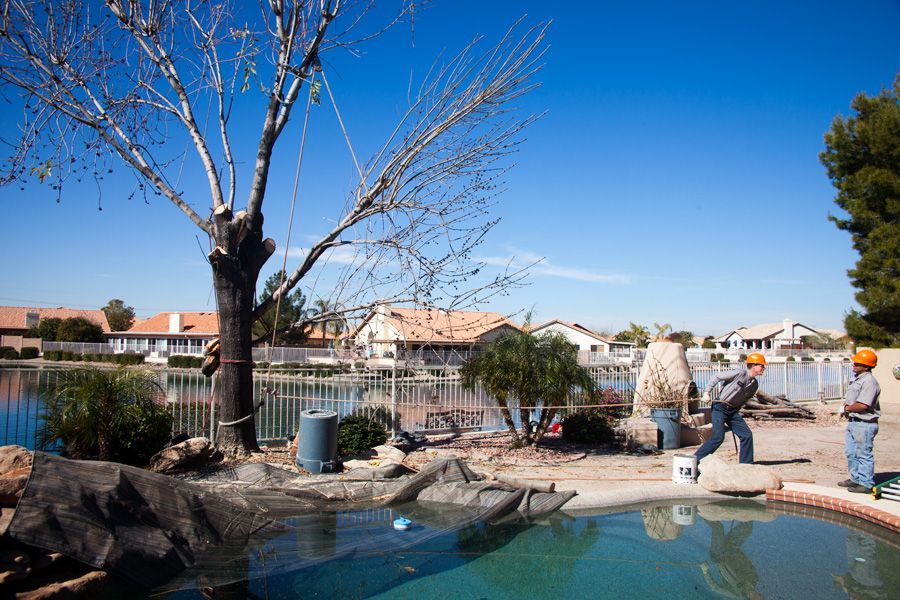Rope Work
Our recent job was taking out two Ash trees in a backyard. Here is a photo taken when we arrived at the job.
Pretty simple? Well, look around! See the iron fence along the back of the yard? See the swimming pool right next to the large tree? See the nice flagstone patio? (there is an elevated portion you can’t see in the photo that would have made getting the lift in here very difficult) There are a lot of targets!
The small tree that Patrick is working on was easy. He cleared the gravel from around the base of the tree, cut off some of the lowest limbs, and then cut it down. It was in the trailer while Jerome and I were still getting out the rest of the gear to rig the larger tree!
The larger tree had been topped at one point in the past which basically ruins its structural integrity. Do you see the point about 2/3 of the way to the top of the tree where the larger branches suddenly split into a bunch of little branches? That is where these branches were indiscriminately cut off (topped) in the past. All the new growth are just suckers – they are weakly attached to material that is rotting! At some point in the future they will get heavy enough to start breaking off. The tree was also right next to the pool and was dropping debris, causing trouble with the filter system. Because of these factors the decision was made to take it out.
Portawrap
The second piece of equipment is an arborist’s block (pulley) which we tie up into the top of the tree. The rope goes from the Portawrap up through this pulley and then to the piece of wood we want to lower. Here is a shot of the pulley and rope tied off to a branch. Actually we used an old topping-cut-stub to loop the sling over, usually we use a “cow-hitch” or “timber-hitch” knot. We have this branch “tip-tied” so that the top will stay up and the bottom will go down when it is cut. When we “butt-tie” a branch, the top falls down and the bottom stays where it is (so the branch flips over). Most of the branches on this tree we tried to “tip-tie” but had a hard time getting them tied off high enough to make the piece fall right. Because of this, we also tied the bottom of the branch to the tree with another rope for extra control.
Ready • Begin
The first picture is everything ready to make the cut.
Now we just need to lower it and cut it up. It often works well to cut pieces off the branch as it comes down (before laying it on the ground). This works especially well when there are a lot of “targets” in the yard.


Lowering the Branch
The lowering of the branch begins. Note that we have protected a prized plant with the trash can and covered the pool for additional safety.
There is really little pull on the rope because of the Portawraps friction. One person can control things very well! The piece can be pulled away from the tree to a landing zone quite a ways away if you pull and lower in a coordinated way. Isn’t it a beautiful day?
This all works great while there is a place to put the arborists block, but how do we get down the last part of the trunk? It is fairly simple to move the pulley down the trunk a ways, run the rope through it and tie it off above the pulley. Then the trunk is cut off between the pulley and the tie-off point. The piece that is cut comes crashing down, but is caught by the rope and pulley before it hits the ground (or anything else!). That works fine until you get so low that the piece that is cut off will hit the ground before the rope comes tight. Where there is room, we just drop the last trunk section right onto the ground.
Lastly the Trunk
Here we didn’t have that option although my men really wished we did! So, we got out the big step-ladder and started piecing out the trunk. We cut through the trunk from one side about half way through. Then cut from the other side about half way through, making sure that the two cuts overlapped across the diameter of the trunk but did not meet (one has to be higher than the other). Then the saw can be put away and the piece snapped off and carried down the ladder. It sounds easy, and is, except that the pieces weight a lot!
We got the trunk cut off at close to ground level and then we were left with loading the logs, putting away the equipment and doing a LOT of cleanup – we made a pretty big mess, but we know how to clean up after ourselves!
Interested in our services? We’re here to help!
We want to know your needs exactly so that we can provide the perfect solution. Let us know what you want and we’ll do our best to help.
Tel: 928-231-3549
